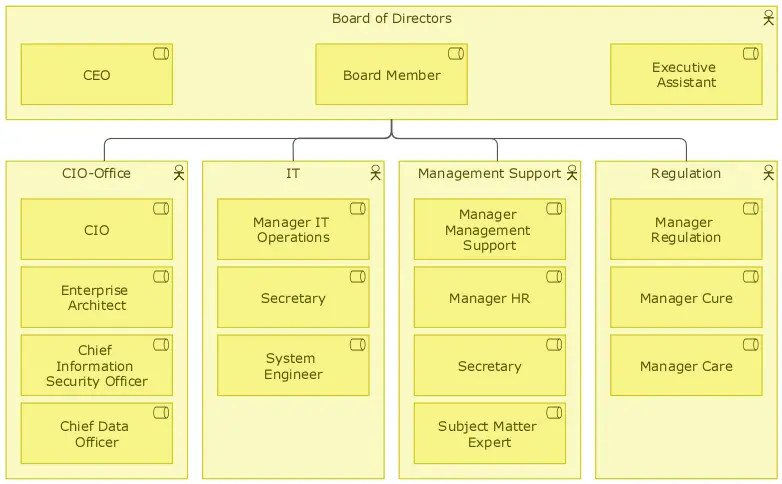Organizational structures are more than just a hierarchy. It is therefore useful to map not only the organizational structure, but also the responsibilities of business units, departments, and other organizational actors. This will create a Business Roles Map. It is advisable not to limit the view to the usual and more formal actors; informal stakeholders can be just as influential as the formal ones.
To define the different roles within an organization, the architecture concept of business role is used.
Definition
A business role represents the responsibility for performing specific behavior, to which an actor can be assigned, or the part an actor plays in a particular action or event [1].
As the definition indicates, a business role represents the responsibility for performing certain behaviors within the organization. This behavior refers to the performance of tasks associated with that role. This can include performing management tasks or tasks associated with a specific function.
Applying the method
When modeling business processes, business roles are used to define who is responsible for specific activities or tasks. By assigning business roles to process steps, architects can easily identify the actors involved in each activity and understand the flow of work within the organization. Business Roles help define responsibility and accountability within an organization. By assigning roles to specific tasks, it becomes clear who is responsible for the successful completion of each task, promoting better governance and decision making.
By using the business role concept, the governance structure of the organization can be visualized. For example, a business roles map can provide insight into the positioning of the architecture capability within the organization. A Business Roles Map goes beyond an organizational chart.
Gathering information
To capture the different roles within an organization, the following questions can be asked:
- Who reports to whom or is accountable for work done?
- Who is accountable for the work done?
- To whom does the business unit or department head report?
- What departments does the business unit consist of?
- What is the hierarchy of the department or unit?
- Are there additional roles that someone in the business unit or department performs?

Gaining an understanding of the different roles that exist within the organization helps to create a Business Roles Map. The answers to these questions can be used to create a more detailed map than, for example, an organizational chart.
Creating the map
When visualizing business roles, try to keep the diagram or map clean.
- Leave out the business roles that do not play a significant part in the overall picture.
- Make sure to include all the roles in the Architecture Repository.
More information
For additional information about creating a Business Roles Map, please refer to Chapter 8, Section 8.2.1.1, of my book Getting Started with Enterprise Architecture.
Back to
[1] The Open Group, ArchiMate® 3.2 Specification. ’s-Hertogenbosch: Van Haren Publishing, 2023.
